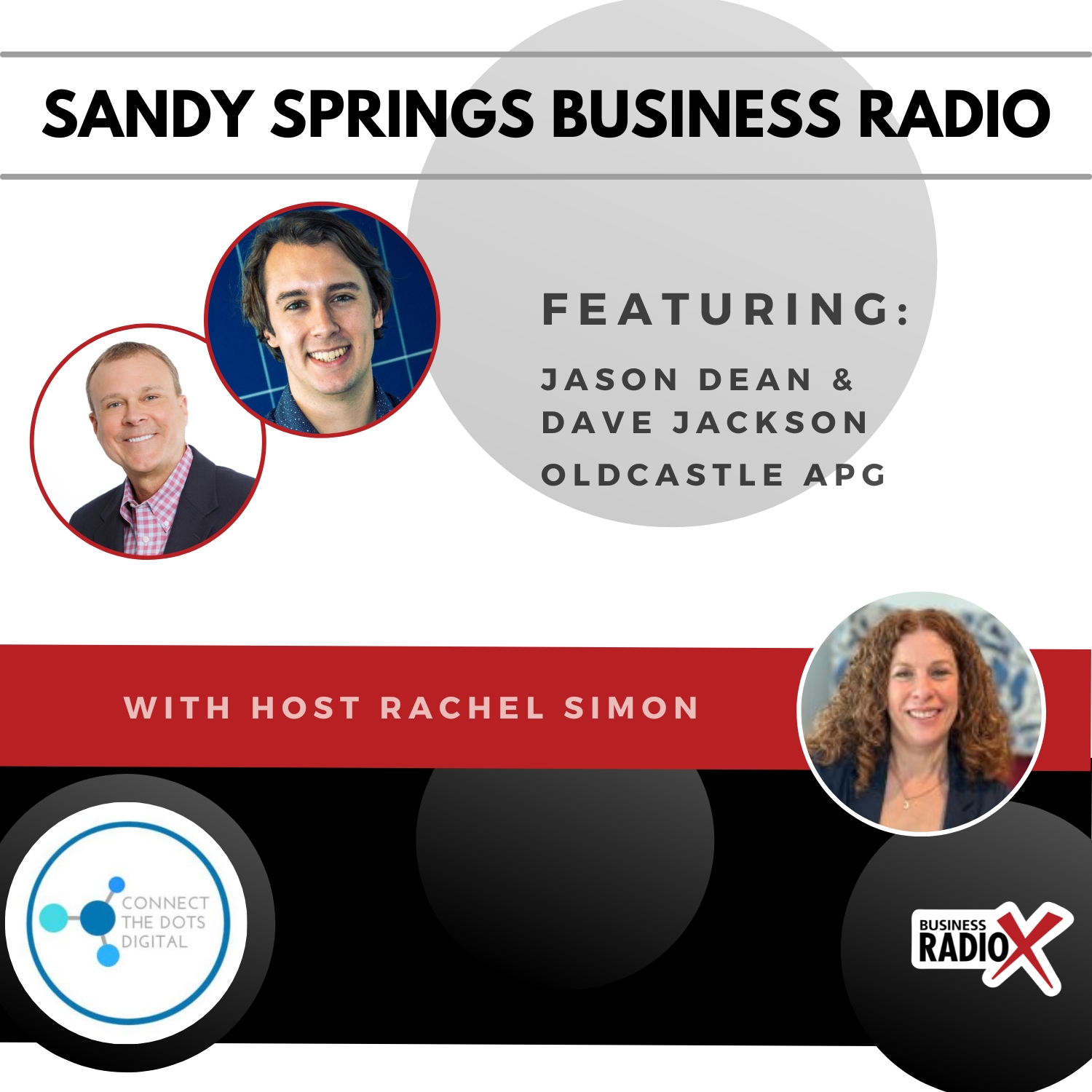
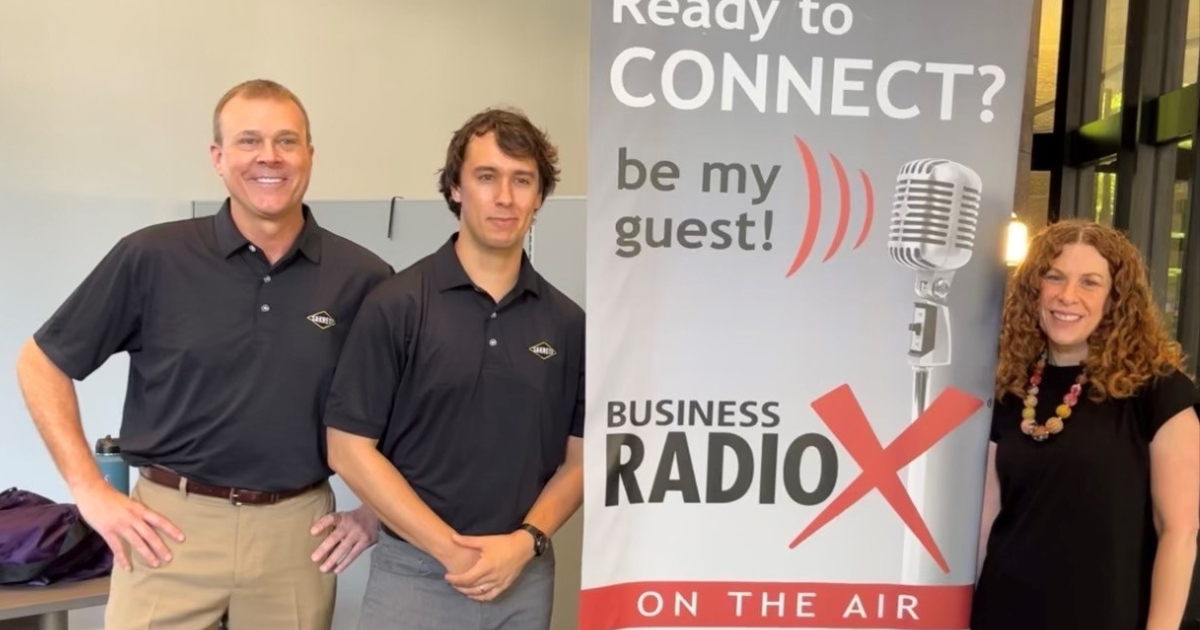
On today’s Sandy Springs Business Radio, hosts Lee Kantor and Rachel Simon talk with Jason Dean and Dave Jackson from Oldcastle APG. Jason discusses his journey from the US Coast Guard to the brick and block industry, while Dave, who handles branding, shares insights into the company’s marketing strategies. Oldcastle manufactures a variety of outdoor products and the conversation covers the company’s focus on customer relationships and the integration of sales and marketing. The guests also discuss the impact of the pandemic on outdoor living trends and Oldcastle APG’s participation in HGTV’s dream home program.
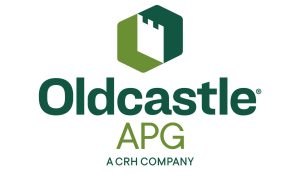
 Dave Jackson is Senior Brand Manager, Oldcastle APG, leading all aspects of brand strategy and managing marketing and advertising efforts for brands including Sakrete, Amerimix, Echelon Masonry and Belgard Commercial.
Dave Jackson is Senior Brand Manager, Oldcastle APG, leading all aspects of brand strategy and managing marketing and advertising efforts for brands including Sakrete, Amerimix, Echelon Masonry and Belgard Commercial.
Utilizing more than a decade of experience, Dave’s innovative mindset and customer-centric approach have propelled APG’s dry mix, masonry and hardscapes business to new heights and exceptional growth.
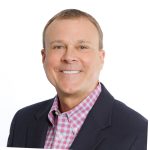 Jason Dean is Senior Vice President of Pro Sales of Oldcastle APG, leading all aspects of national sales efforts for the professional division across the organization’s hardscapes, masonry and dry-mix business. With nearly 30 years of company experience and industry insights, his keen leadership skills enable him to develop effective sales strategies, drive revenue growth and cultivate stronger relationships with existing and prospective customers.
Jason Dean is Senior Vice President of Pro Sales of Oldcastle APG, leading all aspects of national sales efforts for the professional division across the organization’s hardscapes, masonry and dry-mix business. With nearly 30 years of company experience and industry insights, his keen leadership skills enable him to develop effective sales strategies, drive revenue growth and cultivate stronger relationships with existing and prospective customers.
Since joining APG through the acquisition of Georgia Masonry Supply (GMS) in 1994, Jason has held several leadership positions of increasing responsibility and experienced significant success in building and strengthening the pro sales department. A testament to his dedication and expertise, his 30-year career has produced an outstanding track record that has positively impacted our business and continues to serve and address our customers’ needs across North America.
Since being appointed SVP of Pro Sales, he has championed several successful strategies which focus on increasing customer connections, developing strong sales pipelines, collaborating across all brands and honing key markets and prospects. To grow the customer base for a commodity in a static market, he reenergized the network of customers and enhanced relationships with dealers to increase loyalty to the brands.
In addition to customer-centric strategies, Jason championed several creative projects to promote brand awareness, such as Concrete Combat and Sakrete Time, both of which appealed to previously unengaged markets. Jason’s innovative approach to boosting brand awareness and increasing market reach has led to increased revenue in an extremely competitive business.
Follow Oldcastle APG on LinkedIn, Facebook and Instagram.
![]() This transcript is machine transcribed by Sonix
This transcript is machine transcribed by Sonix
TRANSCRIPT
Intro: Broadcasting live from the Business RadioX studios in Sandy Springs, Georgia. It’s time for Sandy Springs Business Radio. Now, here’s your host.
Lee Kantor: Lee Kantor here with Rachel Simon. Another episode of Sandy Springs. Sandy Springs Business Radio and this episode is brought to you by Connect the Dots Digital. When you’re ready to leverage LinkedIn to meet your business goals, go to Connect the Dots dot digital. Rachel, welcome.
Rachel Simon: Hi Lee, how are you?
Lee Kantor: I am doing great! I am so excited about this show. Got a great group here today.
Rachel Simon: Yeah, we’ve got two guests. It’s our first time with two guests. So super excited for that. It’s going to be fun but.
Lee Kantor: That was good. You managed it by being of the same firm.
Rachel Simon: There you go baby steps. Yes. So we are really happy to welcome Jason Dean and Dave Jackson from Oldcastle APG. Welcome. Thanks for being here.
Jason Dean: Yeah, we’re really excited to be here. Thank you so much.
Rachel Simon: Uh, so let’s dive right in. Tell us a little bit about yourself and Oldcastle APG.
Jason Dean: Okay. Um, once again my name is Jason Dean. I’m the SVP of pro sales for Oldcastle APG, and I’ve kind of had an untraditional path to get here today. Um, you know, uh. Early in my career. Um, you know, I was coming out of high school. I went to high school in Maysville, Kentucky, which is rural Kentucky. I wanted to go into law enforcement, so I did a stint in the US Coast Guard. Um, and then went to college, um, using the GI Bill, which is always a great thing. And um, studied criminology corrections in there. And then when I got out, I was trying to really decide what I wanted to do with my life in law enforcement. My uncle had a brick and block company here in Atlanta, Georgia, and he said, hey, while you’re thinking about your next step, why don’t you come down and sell for me for a short period of time? And then, um, you can see where your career takes you? Well, that was 30 years ago. Um, started my career in 94, and it’s been a it’s been a really good ride. Once you get sucked into this industry, you just can’t get out of it. Um, it’s been a great career. It’s not over yet. Um, and the thing probably the most exciting about working with Oldcastle APG is, you know, we’ve got the same core values, integrity, creative community. Um, our our three big ones. But, um, the respect for our employees is probably number one, um, regardless of their background and beliefs. So, um, great working environment, great company. And happy to be here.
Rachel Simon: Awesome. Well, tell us a little bit about yourself, Dave. Yeah.
Dave Jackson: Dave Jackson um, I come from the agency world, so, uh, most of my career has been in marketing, and actually before that I tell Jason. And actually, that’s my story. I’ve had two jobs. I’ve either worked in hardware or I’ve done advertising. So working at Old Castle now for a little over five years is kind of a beautiful synthesis of the stuff that I’ve, uh, done throughout my career. So, uh, I run branding for a couple of our brands in Oldcastle, APG, working really closely with Jason and the sales team, um, most notably being Sakrete, which is the bagged concrete brand, the original bagged concrete brand. It’s important to note, um, and I think we’re going to spend some time talking about that today. Yeah.
Rachel Simon: So, um, first of all, I love nontraditional paths because it’s always great to tell that story of like, how did you end up doing this? Um, those are always fun. So yeah. Tell us a little bit about specifically what Oldcastle APG does, who your customers are, because it may be a brand that our listeners are not familiar with. Sure.
Jason Dean: So. So we’re part of CRH and Oldcastle. We’re a leading product manufacturer in North America and probably one of the biggest companies you’ve never heard of. Um, we we’re a family of brands. And kind of our mantra right now is live well outside. Right. So we play in a lot of spaces, um, including pool finishes and landscape products, masonry fencing and railing, composite decking, soils and mulches. And then once again, of course, our Sakrete brand, which we’re really proud of from, um, originated in 1936, um, as Dave mentioned.
Rachel Simon: So chances are somebody who has an outdoor space has probably has products from your company.
Jason Dean: Absolutely. We drive I get texts and emails all the time. There’s always people going, hey, I saw your product here. I saw your product there. Um, actually, my daughter was in New York City a couple of weeks ago and sent me a picture of a pallet of sakrete in downtown New York City. So it’s always fun to see our products, um, kind of out there in the real world. Yeah.
Rachel Simon: And it’s a global company, correct?
Jason Dean: We are. We’re a global company. Yes, ma’am.
Rachel Simon: Um, very, very interesting. I mean, especially I’ve been begging for a deck at my house, so maybe someday I’ll have some Oldcastle APG materials at my home. Well, you know.
Jason Dean: Who to call.
Rachel Simon: You do? There you go. Um, yeah. So tell us what. What’s sort of your differentiator in the market?
Dave Jackson: Well, you know, I think we work in a very interesting space where, you know, at the end of the day, building materials are a bit of a commodity product, especially bad concrete. It’s probably one of the worst offenders. That bad concrete, at the end of the day is sort of bad concrete. So what it really comes down to for us is how can we get closer to our end users and solve problems for them, because it’s really not all about the material. At the end of the day, concrete is concrete is concrete to a certain extent. What we spend a lot of time thinking about and driving, I think both from a sales and marketing standpoint, is how can we make APG a customer or a business that our customers want to do business with? How can we make their lives easier? How can we help them make more money, get the job done faster, easier, more efficiently? So I think that’s really the thing that from a conceptual standpoint, sets us apart is that starting from the customer’s point of view rather than our own.
Speaker6: Yeah.
Jason Dean: And we focus on building relationships, right? Because we’re in a relationship business people buy from people, and we want our customers to feel confident in doing business with Oldcastle, because providing the highest level of service and quality products is. Kind of our day to day goal.
Lee Kantor: Now, from a B2B standpoint, obviously you’re working with people who are dealing with the end user. At the end of the day, how does sales and marketing kind of work together? Like our sales kind of the front line. You’re learning what your customer needs are and you’re trying to stay ahead of that and you’re listening to their concerns, and then you’re sharing that with marketing or like who who’s kind of driving and who’s kind of reacting to the information that’s gleaned.
Dave Jackson: Well, I’d say if you’re doing it right, the information is flowing in both directions. You know, the sales team is definitely the front line. They’ve got the best read on who the customers are, what they need, what the competition is doing. That obviously has to be fed into marketing for us to spin, for lack of a better term. And then we on the marketing side, I think, have to be well versed enough in the sales process to give the sales team information, assets, campaigns that solve that problem for them, because sales guys are great at selling, and if we can help them tell a really good, compelling story, they’re the the best voice that we have out in the market.
Lee Kantor: So do you have a mechanism that allows the sales folks to bubble up those stories? How does that come about?
Jason Dean: Yeah, so so being a big company, we do a really good job of collaborating across the sales team and the marketing team. The good news is Dave and I have worked really close together for, you know, for a few years here at corporate. And we do we take stories from the field and it’s all about the customer. We listen to the customer and understand what their needs are. And it’s not just the customer that’s buying the material. We talk. We made a pivot the last few years and we really focus on the end user, okay. Because that’s really important information of what the end user actually needs to be successful in the field. And then we take that back to Dave. And Dave puts wonderful spins on and gives us good ideas of kind of how we can take what our customers need, the end user needs, and spin that into a story that that really resonates in the marketplace.
Rachel Simon: Is the end user like a contractor? Like who? Who would be other examples of who that end user might be? We’ll have.
Jason Dean: Diyers. Yeah. You know, the Weekend Warrior, they’re doing their own projects. And then a lot of pro customers, you know, the pro customers, you really don’t. You know, we always joke about where does Sakrete end up. We sell so much sakrete, you know, one year we sold enough sakrete to go around the world like three times. If you take the bags end to end and a lot of it ends up in the fencing world, a lot of it ends up in repair products. So it’s kind of it’s kind of fun seeing and we’ve seen some outlandish ways that our products are used and we’re like, I probably wouldn’t do that. But it’s it’s always been fun to kind of see kind of what’s going on in the marketplace and how they’re using our products.
Lee Kantor: Now, you’ve been in the business for so many years. How have you seen it evolve in terms of kind of learning from your customer? Have you seen some things like, oh, we didn’t think of that, but the customer did, and now that’s a whole, you know, big part of our business now.
Jason Dean: Yeah, we have, you know, when when the brand started in 1936 obviously I wasn’t around in 1936. But you know, over, over the past few years, we’ve kind of dug in and we’ve understood that, um, you know, even though it’s just concrete and it’s repair products, um, they’re used in so many different ways. And we always try to find that niche use that we haven’t thought of.
Lee Kantor: Um, can do you remember any that stands out to you in the years that you’ve been doing this? That something was like, oh, wow. That’s that’s pretty clever there.
Dave Jackson: Well, you know, I think to your point about trying to really nail down who our customer is, what they care about, who they are. As as people has become more and more and more important because especially when we’re selling commodities, it’s how do we set ourselves apart? It’s by being smarter, more relevant, more connected. And I think the one that jumps to mind immediately for me is the fact that we have just in the past year or two years, started doing a very, uh, focused Hispanic marketing effort, uh, which frankly, and this is, you know, egg on my own face, something that we should have been doing for a long time. Um, statistically, just based on census data. Hispanic customers and Hispanic pros are 30% of the construction market, and that’s a low number, I would imagine. So the fact that we had been. What, man? Not not intentionally, but unconsciously, leaving them out of our our communications. And the story that we’re trying to tell was a huge gap that we needed to fill. And I think in the past year and a half, two years, the efforts that we’ve made to really make sure that we are speaking directly to that customer and making sure that they see, you know, feel heard and represented and respected is a very big deal for us. And just I’d say that’s a good sort of encapsulation of our ethos around making sure that we’re delivering solutions for the actual customer. Yeah.
Jason Dean: And based on some of that feedback we’ve gotten from our customers, we have created products maybe that are more fast setting, maybe that the extended working times, there are certain things that the Concrete Pro is looking for to be able to do their job efficiently and effectively. And I think we’ve we’ve made some tweaks along the line of finding what that what our customers are really needing. And we’re still listening to them. You know, we listen to them every day. Um, you know, we’re very connected to that end user. And if we find that, um, if we find that we’re missing a, we’ve got a gap in our portfolio, then we quickly figure out a way to fill that gap.
Speaker6: Yeah.
Rachel Simon: So when you’re, you know, trying to using your example of kind of getting tapping deeper into the Hispanic market, are you connecting with them at conferences like in print? Like how where are you tapping into that audience?
Dave Jackson: So there’s I’d say there’s really two big ways. And what’s really interesting, not just about that, that customer and that market. I’d say this is a general rule, but the idea of getting involved in their in the community, having a voice, having a presence, being, um, seen essentially, you know, but being in an organic, authentic way is what’s really important. And I’ll say in particular for Hispanic pro social media has been a really strong entry point for us. Um, obviously it works very well, general market, but there’s what we’ve found is that that is really such a big point of community for the Hispanic pro. They have a ton of pride in the work that they do, sharing that on social building, kind of that community, even though it’s not in person, is something that we’ve been able to tap into. And I think make sure that we’re, you know, authentically engaging with them through that direction.
Rachel Simon: Yeah. Which channels are sort of the most successful for you?
Dave Jackson: The, the big ones? Um, TikTok and Instagram are definitely the big two. Um, we’re working with, um, a couple of influencers over on that side. And, and I would say those are definitely the big two. So it’s short form, mobile driven, uh, relatively young audience. And just from a digital penetration standpoint, you know, the Hispanic pro is very, uh, overindexes on sort of their interest in social media.
Rachel Simon: Linkedin is is beta testing short form video again. So just.
Speaker6: Interesting.
Rachel Simon: Put that on your radar.
Speaker6: Put that in put.
Dave Jackson: That in the queue. There we go.
Lee Kantor: Now is there any advice for other firms that you’ve mentioned several times here how important it is to have that collaboration between sales and marketing? Is there any kind of advice or tips you can give an organization to create that level of communication and clarity of messaging when it comes to having a good working relationship between sales and marketing?
Jason Dean: You know, I would say that, um, it goes hand in hand, right? If companies keep those departments so separated that they’re not collaborating on a day to day basis, they’re going to miss out. And that’s one thing that we’ve done really well is we’ve brought the teams together on the marketing and sales.
Lee Kantor: So that’s from a cultural standpoint. You think the culture of the organization is such that it kind of lends itself to this level of collaboration and and teamwork, whereas some of them, as you mentioned, are siloed. Some organizations may be culturally dysfunctional or siloed. And then it’s they’re they’re kind of adversarial rather than collaborative.
Speaker6: Absolutely.
Jason Dean: And I think our culture, um, is one thing. And then our focus on the customer, right? We we focus on our customer and we focus on the end user. And I’ll keep saying that because that’s such a foundation of what we do and how we’ve been successful. Um, you know, brands don’t stay around for almost 90 years. Um, if they don’t have that.
Dave Jackson: And I think you’re right, it is that that culture. And that’s something that I try and reinforce to my team. Is that really marketing done right is a sales support function. But I think that that your point about customer first is really the ethos that brings us all together and points us in the same direction.
Rachel Simon: Yeah, I’ve seen just in my, uh, observation from different companies that a lot of times one of the reasons why there’s misalignment is lack of clarity on who owns what, right, who’s. For this function. And, you know, sales thinks its sales marketing thinks its marketing or vice versa. And then it’s like, let’s all play together. We all have the same goals. We. So kudos to you all for really sounding like you’re doing an amazing job of collaborating.
Jason Dean: And one other thing I would say is, um, you got to be willing to change course, right? You know, I mean, there’s we’ve said and we’ve said in rooms for hours, Dave and I have and we’ve, we’ve thought we had it all figured out. We do something, we make a change. We we we pull out an ad, and then all of a sudden we’re like, no, we need to we need to tweak this and we need to hit the market again with a different message. So you have to be willing to to change course if needed. Um, but once again, it does. It comes back to that collaboration piece is so important from a sales and marketing group.
Dave Jackson: And having a bit of humility, I think that we don’t necessarily have all the answers. And it’s, you know, reaching across the aisle and making sure that we’ve got sort of everything considered.
Lee Kantor: Now, how has the kind of outdoor, uh, architectural or landscaping, um, industry as a whole changed? Is it is this now more of a must have for people in their homes, or is it is that trend going or is it, um, you know, kind of a nice to have.
Jason Dean: Well, well, I think during, during Covid, um, it changed a lot. I think a lot of folks at home, you know, they would spend time in the out in, in their backyard. Right. Um, when Covid happened, they had to spend time. It wasn’t it wasn’t a maybe we will we have to because we can’t go anywhere. And we saw a really boom. And that’s kind of why we we changed our mantra on on our outdoor living segment to live well outside. People feel better when they’re outside, right? Um, you’re healthier. You feel good. So we we’ve kind of gone all in. And what we’re trying to do is we want to be a family of brands that play in the, in the backyard and be able to, you know, from the pool, finish all the way to the fence when you’re done. We want to be able to play in that space.
Lee Kantor: So are there some things that are are that we can look forward to, maybe trends that are upcoming that people, homeowners can, uh, you know, either aspire to get or start thinking about putting into their household budget when it comes to outdoor elements.
Speaker6: Yeah.
Jason Dean: So we offer a lot of elements in the outdoor. We’ll do we do everything from kitchens, um, you know, we can do the art forms, kitchen packages, which are really popular right now. But but I really don’t think the products have changed much overall. You know, when you look at your outside, you think about a nice deck, a fire pit, a swimming pool, an outdoor kitchen. We’ve played in those spaces for several years, but we’re being a little bit more intentional today on kind of how we talk about those products and make sure that customers know that, hey, these are available in your market. And, um, it’s just a matter of picking and choosing what your backyard wants to look like. And we help with design as well, and through our belgard business. So, um, you know, we we’re all in. And if people go to the website Oldcastle apg com, they can see and they can pull up the belgard, um, side of our business and really see what we offer from from that backyard solution.
Rachel Simon: Are you doing commercial spaces as well?
Jason Dean: We do. We’re heavily involved in. I’ll let Dave talk about the HGTV. We’re the dream home. We’re we’re heavily involved in that program every year, which is phenomenal. Um, so you can if you watch HGTV, you’ll definitely see our commercials there. Um, on that side of the business as well.
Lee Kantor: Has has that changed kind of people’s expectations, like those type of, uh, shows where they see like, oh, this is out, this is possible. Now why can’t I have one?
Speaker6: Yeah.
Jason Dean: And all you got to do is you got to figure out what you want and make sure it works in your budget. And the good news is, is, is we’ve got, um, we’ve got you can get a nice backyard upgrade what you have now for $5,000. Right. Or you can go out and spend $200,000.
Lee Kantor: You can spend as much as you want.
Speaker6: I’m sure you can.
Jason Dean: Spend as much as you want. So. So that’s the thing. We appeal to all, all sides of that. Um, and we’ve got products that, that we make that will work in, in each, you know, each segment of, of whatever your budget might be.
Speaker6: Yeah.
Rachel Simon: That’s a very cool brand partnership with HGTV, I’m sure.
Jason Dean: Oh it is, it’s been long standing and it’s great. And our customers love it. And and it does. It’s it shows the possibilities of what you can do outside, um, understanding, you know, that there’s budget constraints for everybody. But we can we can hit each bucket and get them something really nice that that works. So you get.
Rachel Simon: To go to the dream home every year when they do their HGTV dream home.
Jason Dean: We do. Yeah, we’re heavily involved in the dream home, um, stuff and, and our, our, our president, Tim Ortman and Jenny Nail, our, um, chief revenue officer, they’re heavily involved in in those as well. So it’s a team effort, um, on kind of our marketing side and, and what we talk about on a daily basis to live well outside.
Lee Kantor: So what is an element you’ve seen somewhere that you were like, oh, I didn’t even I couldn’t imagine something like this. Like what’s kind of the most, I don’t want to say outlandish but maybe most extravagant outdoor.
Dave Jackson: You know, I actually don’t think that it’s extravagance so much as the transformation element of seeing someone’s backyard, you know, as it was torn down to the studs and then rebuilt into something that is completely different. Um, that is what gets me really excited personally. Is that potential for change and how much you can do with the space that you have? Because we all know that, you know, housing market’s real tough right now. So people are not buying their way into these upgrades. You kind of have to build with what you’ve got. But I think the fact that you can take a boring, basic builder grade backyard and really turn it into an oasis using a combination of all of our products is really powerful and exciting to see out in the world, because.
Lee Kantor: You see sometimes, like in a hotel or you travel, you see a resort kind of experience outdoors, and all of a sudden now you’re seeing some backyards that are having kind of some of the elements that were only in like high end.
Dave Jackson: Absolutely.
Speaker6: I think it’s yeah.
Jason Dean: It’s absolutely amazing. Some of the stuff that we see because we, you know, we do our obviously we do our belgard catalogs every year and things like that. And we get submissions in and, and some of these backyards. Outlandish is a good word to use. They’re crazy. I mean, we see everything from, you know, full kitchens, um, you know, pool slides. I mean, really, the sky’s the limit. And, um, and a lot of folks, you know, they’re I mean, that’s a living space anymore, right? You know, we’re years ago, it wasn’t a living space. Um, you know, over the last few years, you know, we’ve changed that. We’re like, hey, I’ve got this backyard. So that’s an extra room. So that’s the way we.
Lee Kantor: Look, right? So they’ve kind of in their mind, they’ve reframed what their backyard could be, where it was like grass and a swing set maybe. And now it’s like you said, it’s another room. This is more square footage for my house to make it more valuable and more. Yeah. Um, you know, better for me currently and for the future owner if I sell this.
Speaker6: Sure.
Jason Dean: Absolutely. And it’s more livable. And people, obviously, you know, with what’s going on with interest rates and how and home prices, people are saying, hey, I could do this and move and spend this much money, or I could invest in my property and, and make it nicer for, for me and for my kids. And, and we see that. And that’s the most exciting part about being part of a progressive company is we have all these products and we do we we, you know, we want to own the backyard, and we want our contractors and customers really to be able to come to us. And then we can provide a solution so they don’t have to go to ten different vendors to, to accomplish what they want to accomplish in their backyard.
Rachel Simon: This is what I aspire to in my backyard.
Speaker6: We can help.
Jason Dean: I told you, we can help you.
Lee Kantor: It’s also you’re helping them think bigger. You know, they might not even know what’s possible, but you’re giving them an idea of what could be. And then, like you said, you can take baby steps to get there.
Jason Dean: Yeah, Belgacom there’s a lot of stuff on that. So if people want to start at least looking at what, you know, kind of.
Speaker6: The possibilities.
Dave Jackson: Getting it out of getting out of Pinterest mode, out of inspiration and actually trying to put some bones around that, like, hey, this is what I could theoretically achieve. So as she writes down Bellosguardo.
Speaker6: There you go.
Rachel Simon: Um, yeah. So tell us a little bit again. You’re based here in Sandy Springs. What are some examples in the area, some success stories we could potentially see in our community here?
Speaker6: Oh, it’s.
Jason Dean: Kind of funny you say that. So, um, you know, Georgia Masonry Supply is our local business here, and we’ve got block, paver and dry mix plants over, um, just a couple jobs that that you would probably see us at is the the Sandy Springs, Sandy Springs city center. We were heavily involved in that, the Abernathy Greenway. We’ve got hardscape products there. And then right now we’re doing the Sandy Sandy Springs Police headquarters, um, that’s actually under construction. And then not to mention the hundreds or thousands of backyards that that are around our community right now that have product going in. Um, you know, it’s funny, I was talking to somebody this morning and I was talking to Anne Carlson, and she’s in our office this morning and she’s like, yeah, she lives in Sandy Springs. And she’s she was out for a walk, and she sees belgard pavers and sakrete on her walk every week. She sees a house that’s doing a certain project. So you’ll see our a lot of folks, they use our products every single day and they just don’t realize it. Um, so.
Speaker6: Yeah.
Dave Jackson: And I’m still at the point where I get excited when I’m like, oh, look, that’s our block. My, uh, my wife’s about tired of hearing about it, but it’s still exciting to to see our stuff out in the wild, I think.
Jason Dean: I love to see it, you know, um, we I was in Salt Lake City, um, several weeks ago, and I was at a stoplight and there was a whole, um, truckload of sakrete next to me that somebody had just picked up. And I just got the. Yeah, I took a picture. I was sitting in a stoplight, so. Safely took a picture, but it’s exciting when you see your products out there making a difference and customers are are raving about our quality and our service. And that’s really that’s why that’s why we do it for that’s why I’ve been here for 30 years. And if they if they keep me around, I’ll be here for another, I guess until they tell me to tell me to leave.
Lee Kantor: And it’s one of those things where everybody is happy around your product. Like when they’re done, they’re they got something they’re proud of. So it must be rewarding work for you.
Speaker6: Oh, absolutely.
Jason Dean: It is rewarding. I mean, you know, that’s the ultimate goal during the construction phase. There’s a lot of hard work obviously. Are we? We always joke our products aren’t real sexy on the secret side of the business, but but our secret products are useful in everything that that we build in the backyard, from the fence to the repair, you know, the.
Dave Jackson: Port walkways.
Jason Dean: And walkways. So but when you get to the final end of that, um, end of that journey on your project, you can look at it and you can be really proud of kind of what we helped create.
Speaker6: Um.
Rachel Simon: Great. Well.
Lee Kantor: And so once again, what are the best websites coordinates for someone to plug in?
Dave Jackson: I start with Oldcastle APG. Com and you’ll be able to access all the other brand sites from there, from belgard to moisture shield decking to Sakrete to pebble tech pool finishes and everything in between. But yeah, old.
Jason Dean: Fencing and Brett fencing business. Um, everything you can you can get from that website.
Rachel Simon: Absolutely. One stop shop. You got.
Dave Jackson: It. That’s the idea.
Speaker6: Stop shop. There you go.
Lee Kantor: And, Rachel, before we wrap and a LinkedIn tip.
Rachel Simon: Uh, yeah, well, not as much of a tip as, uh, some a new kid on the block. Um, so LinkedIn, uh, May 1st rolled out games. I don’t know if you’ve noticed it. There’s three games they rolled out. So now, if you’re on your home screen, kind of underneath where the news is on the right hand column, you’ll see the games there. Um. I think it’s kind of interesting. I’m not sure why they feel like LinkedIn users want to play games on there. Um, sometimes.
Lee Kantor: I think it’s time on site. They want they.
Rachel Simon: Want time on site. They do.
Lee Kantor: More time on.
Rachel Simon: Site. I will be honest. The games are. Not the most fun to play.
Lee Kantor: Uh, there’s not a Wordle in there.
Rachel Simon: There’s not a Wordle. There is like a minesweeper. Oh, my God, I wish right.
Speaker6: Um, bring back minesweeper.
Rachel Simon: Yeah, they should have. Totally. I used to be addicted to that game. Um, so, you know, test them out, see what you think? I. I’m not sure they’re getting the play that they were hoping, because you can kind of see how many of your connections are playing them. And mine is generally around like 10 to 15. And I have a lot more than that. So I just don’t I don’t know, sometimes it’s just an example of they roll out features that. May not be what the users want, but.
Speaker6: Check.
Rachel Simon: It out and see what you think. Let me know.
Speaker6: Absolutely.
Lee Kantor: Well, thank you both for being part of the show today. You’re both doing such important work and we appreciate you.
Speaker6: Absolutely.
Jason Dean: Thanks for having us. We we really appreciate you being here.
Lee Kantor: All right. Lee Kantor for Rachel Simon. We’ll see you all next time on Sandy Springs Business Radio.
About Your Host
 Rachel Simon is the CEO & Founder of Connect the Dots Digital. She helps companies ensure that LinkedIn is working for them as an asset, not a liability.
Rachel Simon is the CEO & Founder of Connect the Dots Digital. She helps companies ensure that LinkedIn is working for them as an asset, not a liability.
Rachel works with teams and individuals to position their brand narrative on LinkedIn so they can connect organically with ideal clients, attract the best talent, and stand out as a leader in their industry.
Rachel co-hosted LinkedIn Local Atlanta this week along with Phil Davis & Adam Marx – a networking event focused on bringing your online connections into the real world.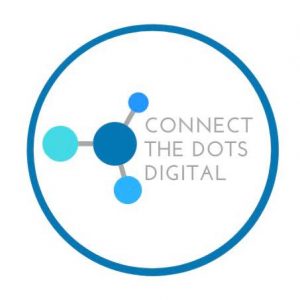
Connect with Rachel on LinkedIn.














